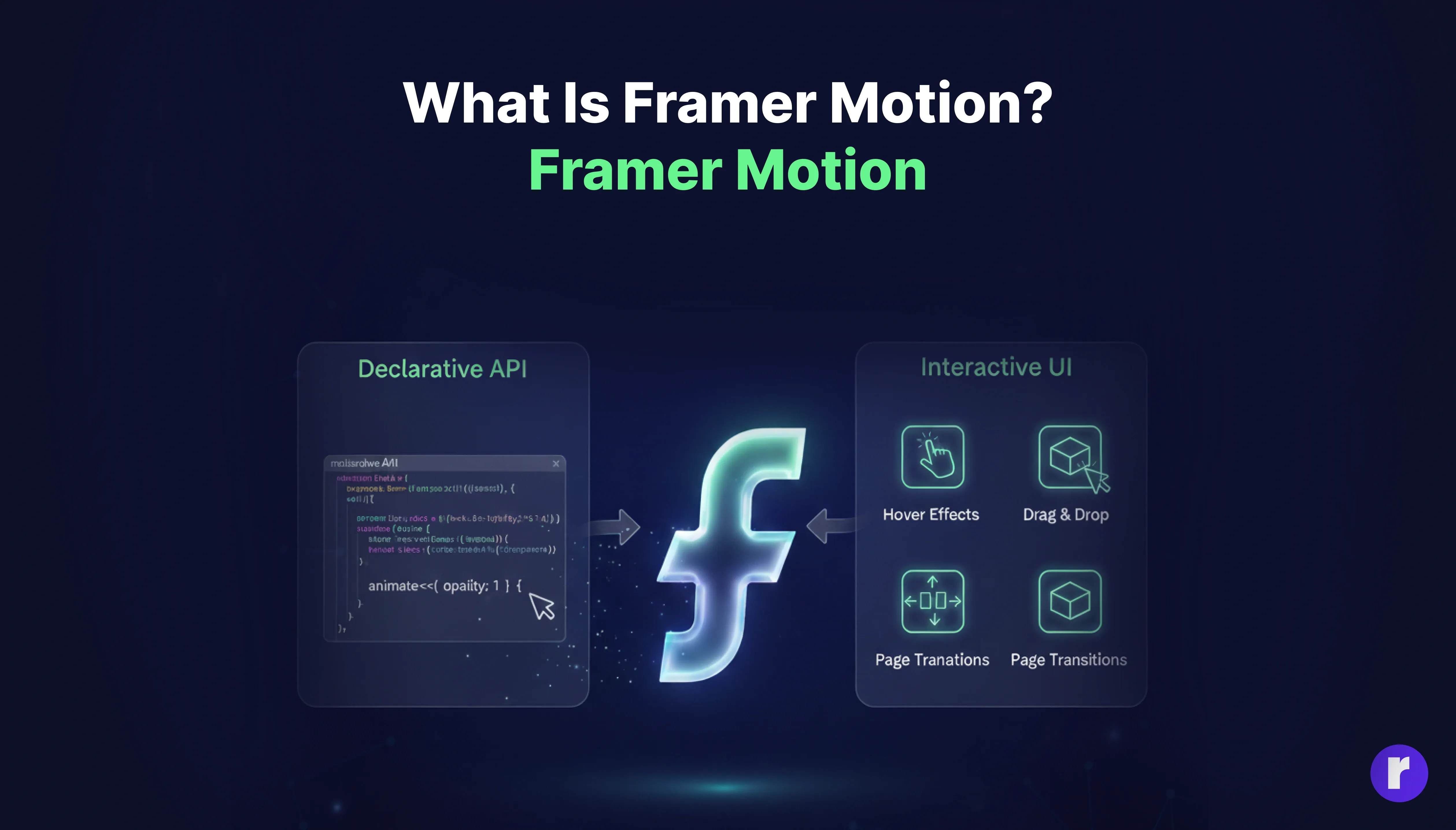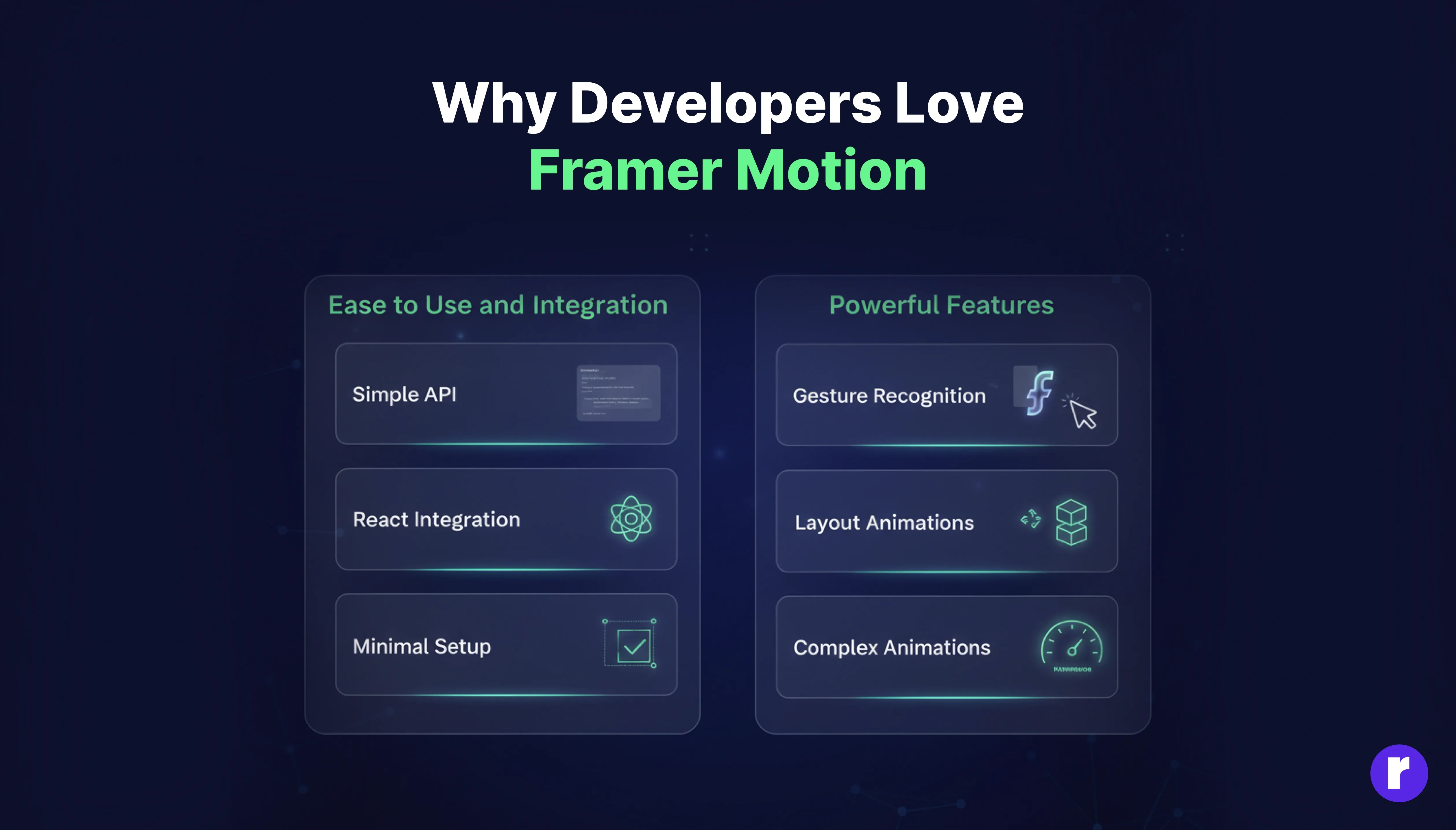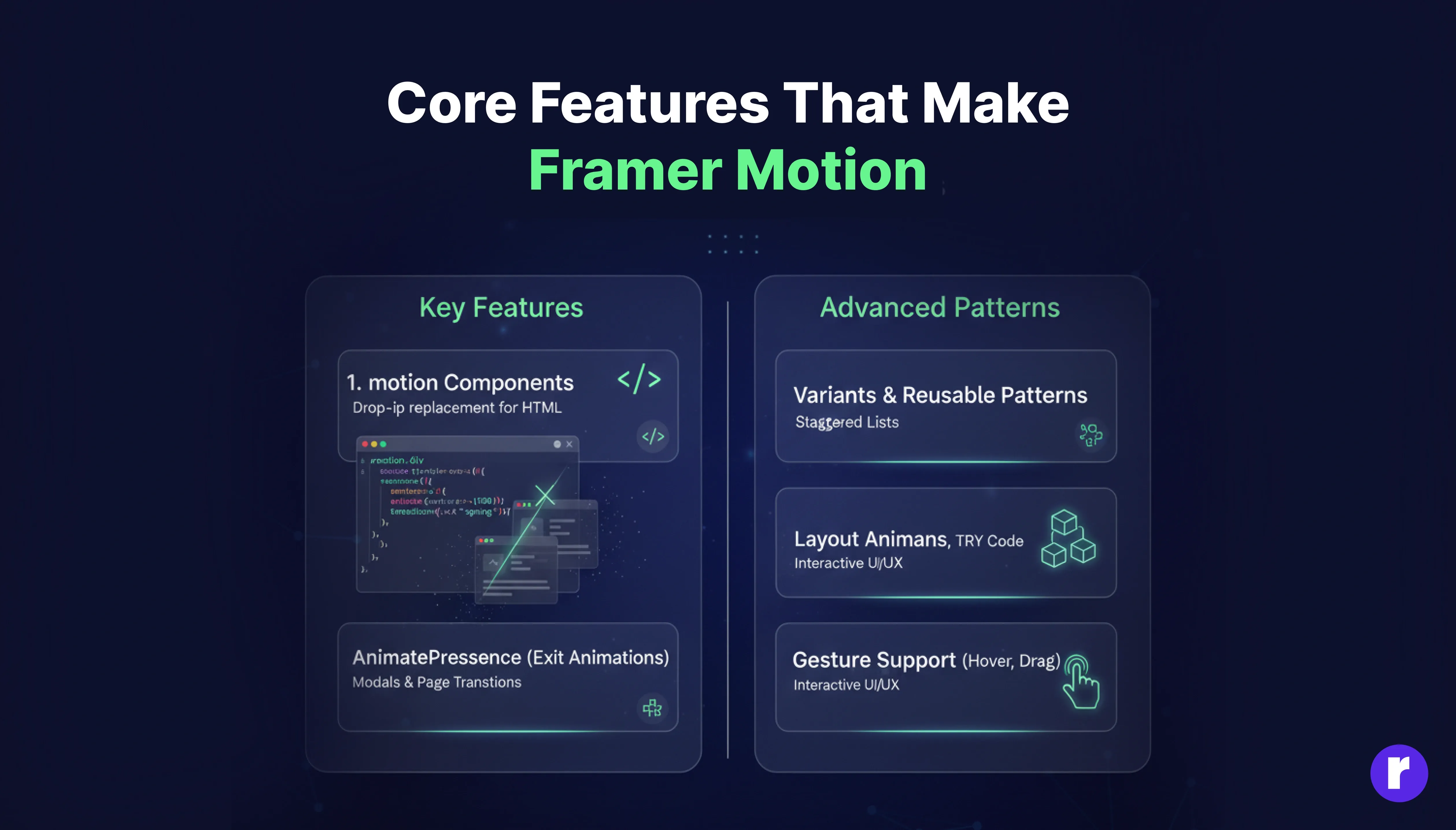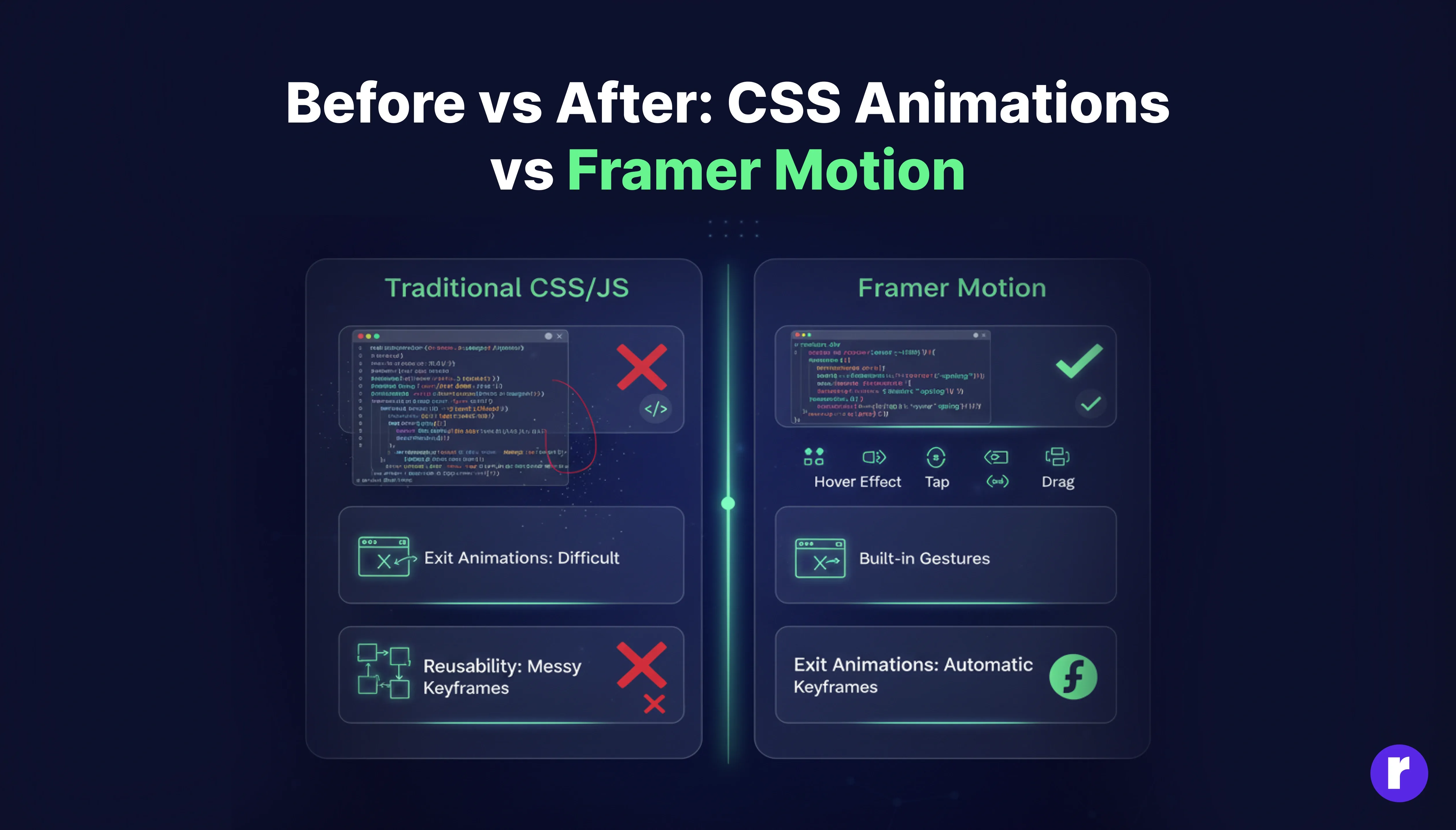Motion Made Easy: How Framer Motion Simplifies Complex Animations

Written by
Vishal Chanda
Front End Developer
Table of contents
Build with Radial Code
Animations can transform a static website into an engaging experience — but writing complex animations manually with CSS or vanilla JavaScript often becomes messy, time-consuming, and difficult to maintain.
Enter Framer Motion — a powerful, developer-friendly animation library for React that makes motion effortless. Whether you’re animating a simple button hover or orchestrating a full-page transition, Framer Motion delivers smooth, spring-based animations with minimal code.
In this blog, we’ll explore what makes Framer Motion so special and how it simplifies animations that would otherwise take dozens of lines of code.
What Is Framer Motion?

Framer Motion is an open-source, production-ready React animation library that makes it simple to add complex animations and gestures with minimal effort.
It offers a declarative API that allows you to create animations directly in your components — no need for extra CSS files or complex JavaScript.
With Framer Motion, developers can easily create:
- Hover and tap effects
- Drag-and-drop interfaces
- Page transitions
- Layout and exit animations
All while keeping the codebase clean, scalable, and easy to maintain.
Radial code is your gateway to mastering motion — learn, animate, and innovate with Framer Motion.
Why Developers Love Framer Motion

Developers love Framer Motion because it combines ease of use, power, and performance in one package.
Its API feels natural to React developers, allowing animations to be declared as part of the component itself.
Ease of Use & Integration
- Simple API: Add animation props like initial, animate, and transition directly to your components.
- Seamless React Integration: Works natively with React’s declarative structure and lifecycle.
- Minimal Setup: Replace HTML elements with motion components, add props, and you’re done — no extra setup required.
- Works With Any Styling Approach: Whether you're using Tailwind, Styled Components, or plain CSS, Framer Motion fits right in without forcing a specific styling method.
Powerful Features
- Gesture Recognition: Built-in support for drag, hover, and tap makes interactions feel alive.
- Layout Animations: Automatically animate changes in size or position for fluid UI updates.
- Complex Motion Control: Supports variants, keyframes, and exit animations for flexible choreography.
- Optimized Performance: Designed to run efficiently, avoiding DOM-related performance issues.
- TypeScript & Accessibility Friendly: Strong TypeScript support and compatibility with ARIA attributes make it safe and scalable for large production apps.
How Framer Motion Makes Animations Easier

Framer Motion simplifies the entire animation process with a declarative approach — you describe what should happen, not how to make it happen.
Key Features That Simplify Animation
- Declarative API: Define animation behavior using initial, animate, and transition — readable and intuitive.
- Variants: Pre-define multiple animation states and reuse them across components.
- Layout Animations: Automatically handle reflow, reordering, and resizing with smooth transitions.
- Gesture Support: Add interactivity with simple props like whileHover, whileTap, or drag.
- Performance Optimization: Animations run on a separate render loop, ensuring a smooth experience.
- Advanced Control: For complex cases, sequencing and controls allow granular tuning of motion.
- Responsive & Adaptive Animations: Framer Motion supports responsive values, allowing animations to adapt based on screen size or conditions—ideal for modern, mobile-first interfaces.
- Exit Animations with AnimatePresence: It allows you to animate components as they leave the DOM, which isn’t natively possible in React, helping create polished page transitions and modals with ease.
Core Features That Make Animation Effortless

Framer Motion includes powerful built-ins that remove the need for manual keyframes or complicated JS logic.
Framer Motion includes powerful built-ins that remove the need for manual keyframes or complicated JS logic.
- Motion Components
- Drop-in replacements for HTML tags like div, img, section, etc.
- Add animation using props such as initial, animate, and transition.
- No need to write CSS @keyframes or maintain multiple classes.
- Works seamlessly with any layout or styling approach (Tailwind, CSS, or Styled Components)
- AnimatePresence (Exit Animations)
- Handle component entry and exit animations smoothly.
- Perfect for modals, conditional rendering, or page transitions.
- Solves one of CSS’s biggest limitations — animating unmounts.
- Ensures UI feels smooth and intentional, rather than abrupt.
- Variants & Reusable Motion Patterns
- Define animation states once and reuse them anywhere.
- Great for staggered animations, coordinated motion, and DRY code.
- Keeps complex animations clean and organized.
- Great for design systems or component libraries where consistency is key.
- Gesture Support (Hover, Tap, Drag)
- Built-in gesture props (whileHover, whileTap, drag).
- No extra event listeners or React states needed.
- Adds natural interactivity and depth to your UI.
- Makes draggable sliders, interactive cards, and playful buttons incredibly easy to build
Before vs After: CSS Animations vs Framer Motion

Traditional CSS or JS-based animations often require:
- Managing multiple keyframes and CSS classes
- Writing repetitive boilerplate code
- Handling complex interactions manually
Framer Motion replaces this with one clean, declarative syntax —making even advanced animations easy to read and maintain.
Key Differences
- Code Complexity
- CSS : Requires separate files, keyframes, and classes. Hard to manage.
- Framer Motion: One-line animations directly in React components.
- Interactivity (Hover, Tap, Drag)
- CSS: Hover only. Drag or Tap requires JavaScript.
- Framer Motion: Built-in props like whileHover, whileTap, drag.
- Page & Exit Animations
- CSS: Difficult to animate component unmounting.
- Framer Motion: AnimatePresence handles enter/exit automatically.
- Reusability
- CSS: Reusing keyframes across components is messy.
- Framer Motion: Variants make animations reusable and maintainable.
- Advanced Motion (Physics & Stagger)
- CSS: No physics, manual delays for stagger.
- Framer Motion: Built-in spring, tween, inertia, and staggerChildren
When Not to Use Framer Motion

While Framer Motion is powerful, it’s not the right fit for every project.
You might want to skip it if:
- You’re not using React (e.g., Vue, Angular, static HTML).
- You only need basic transitions (simple fade or hover — CSS is enough).
- You’re extremely concerned about bundle size.
- You need timeline-based or video-like motion (GSAP or Lottie is better).
- You’re animating hundreds of elements simultaneously and need ultra-optimized performance.
- Your site is static with minimal interactivity.
Framer Motion shines in modern, interactive UIs, but for ultra-light or highly specialized use cases, simpler or more targeted tools may be better.
Conclusion
Motion doesn’t have to be intimidating — when done right, it enhances usability, storytelling, and engagement without adding complexity. Framer Motion embodies this principle beautifully. It offers developers an intuitive, performant, and flexible way to bring life to their interfaces — turning complex motion into effortless, declarative code.
